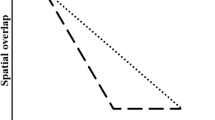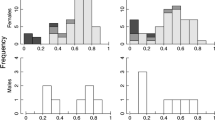Summary
Howling is a principle means of spacing in wolf populations. The relationship between a pack's responses to howling (replies, movements) and its location within its home range, was studied using human-simulated howling in a territorial population in northeastern Minnesota. The results indicated the responses were independent of the pack's location, or the locations of the pack and playback relation to the territory center. These results indicate that howling serves as a territory-independent spacing mechanism, that will result in the use of exclusive territories when coupled with strong, year-round site attachment, but with floating, exclusive, buffer-areas about migratory packs.
Similar content being viewed by others
References
Ballenberghe V Van, Erickson AW, Byman D (1975) Ecology of the timber wolf in northeastern Minnesota. Wildl Monogr 43: 1–43
Brown JL (1964) The evolution of diversity in avian territorial systems. Wilson Bull 6: 160–169
Fritts SH, Mech LD (1981) Dynamics, movements, and feeding ecology of a newly protected wolf population in northwestern Minnesota. Wildl Monogr 80: 1–79
Haber GC (1977) Socio-ecological dynamics of wolves and prey in a subarctic ecosystem. PhD dissertation, University of British Columbia, Vancouver
Harrington FH (1975) Response parameters of elicited wolf howling. PhD Dissertation. State University of New York, Stony Brook
Harrington FH (1981) Urine-marking and caching behavior in the wolf. Behaviour 76: 280–288
Harrington FH, Mech LD (1979) Wolf howling and its role in territorial maintenance. Behaviour 68: 207–249
Harrington FH, Mech LD (1982a) An analysis of howling response parameters useful for wolf pack censusing. J Wildl Manage 46: 686–693
Harrington FH, Mech LD (1982b) Fall and winter homesite use in two Minnesota wolf packs. Can Field-Natur 96: 79–84
Harrington FH, Mech LD (1982c) Patterns of homesite use in two Minnesota wolf packs. In: Harrington FH, Paquet PC (eds) Wolves of the world: Perspectives of behavior, ecology, and conservation. Noyes Publications, Park Ridge (New Jersey), pp 81–105
Henshaw RE, Stephenson RO (1974) Homing in the gray wolf (Canis lupus). J Mammal 55: 234–237
Hinde RA (1956) The biologiycal significance of the territories of birds. Ibis 98: 340–369
Joslin PWB (1967) Movements and homesites of timber wolves in Algonquin Park. Am Zool 7: 279–288
Marler P (1972) Vocalizations of East African monkeys. II. Black and white colobus. Behaviour 42: 175–196
Mech LD (1970) The wolf: the ecology and behavior of an endangered species. Doubleday, New York
Mech LD (1973) Wolf numbers in the Superior National Forest of Minnesota. USDA For Serv Res Pap NC-97, St. Paul (Minnesota), pp 1–10
Mech LD (1974) Current techniques in the study of elusive wilderness carnivores. Proc XIth Int Congr Game Biol 11: 315–322
Mech LD (1977a) Population trend and winter deer consumption in a Minnesota wolf pack. In: Phillips J, Jonkel C (eds) Proceedings of the 1975 predator symposium. University of Montana. Missoula, pp 55–83
Mech LD (1977b) Productivity, mortality, and population trend of wolves in northeastern Minnesota. J Mammal 58: 559–574
Mech LD (1977c) Wolf pack buffer zones as prey reservoirs. Science 198: 320–321
Mech LD (1980) Making the most of radio-tracking—a summary of wolf studies in northeastern Minnesota. In: Amlaner CJ, Macdonald DW (eds) A handbook on biotelemetry and radio tracking. Pergamon Press, Oxford, pp 85–92
Mech LD, Karns PD (1977) Role of the wolf in a deer decline in the Superior National Forest. USDA For Serv Res Pap NC-148, St. Paul (Minnesota), pp 1–23
Murie A (1944) The wolves of Mount McKinley, US Nat Park Serv Fauna Ser 5, Washington, DC, pp 1–238
Parker GR (1973) Distribution and densities of wolves within barren-ground caribou range in northern mainland Canada. J Mammal 54: 341–348
Peters RP, Mech LD (1975) Scent-marking in wolves. Am Sci 63: 628–637
Pimlott DH (1960) The use of tape-recorded wolf howls to locate timber wolves. 22nd Midwest Wildl Congr, pp 1–15 (mimeo)
Stephenson RO, James D (1982) Wolf movements and food habits in northwest Alaska. In: Harrington FH, Paquet PC (eds) Wolves of the world: Perspectives of behavior, ecology, and conservation. Noyes Publications, Park Ridge (New Jersey), pp 26–42
Theberge JB, Falls JB (1967) Howling as a means of communication in timber wolves. Am Zool 7: 331–338
Voigt DR (1973) Summer food habits and movements of wolves (Canis lupus L.) in central Ontario. MS thesis, University of Guelph
Waser PM (1975) Experimental playbacks show vocal mediation of avoidance in a forest monkey. Nature 255: 56–58
Waser PM (1977) Individual recognition, intragroup cohesion, and intergroup spacing: evidence from sound playback to forest monkeys. Behaviour 60: 28–73
Waser PM, Wiley RH (1979) Mechanisms and evolution of spacing in animals. In: Marler P, Vandenbergh JG (eds) Handbook of behavioral neurobiology, vol 3. Plenum, New York, pp 159–223
Weise TF, Robinson WL, Hook RA, Mech LD (1975) An experimental translocation of the eastern timber wolf. Audubon Cons Rept 5: 1–28
Wiley RH (1973) Territoriality and non-random mating in sage greuse Centrocercus urophasianus. Anim Behav Monogr 6: 85–169
Author information
Authors and Affiliations
Rights and permissions
About this article
Cite this article
Harrington, F.H., Mech, L.D. Wolf pack spacing: Howling as a territory-independent spacing mechanism in a territorial population. Behav Ecol Sociobiol 12, 161–168 (1983). https://doi.org/10.1007/BF00343208
Received:
Accepted:
Issue Date:
DOI: https://doi.org/10.1007/BF00343208




